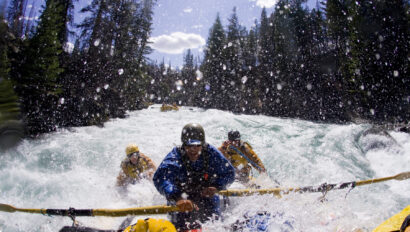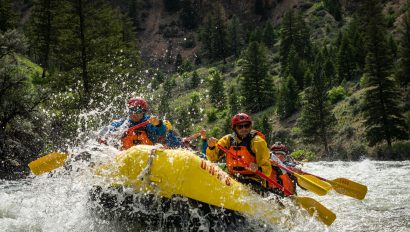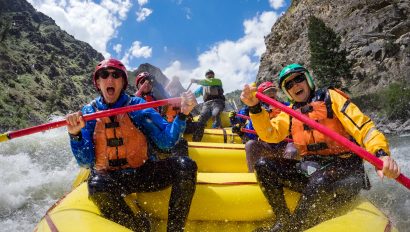2021 Rafting Outlook: Business as Usual Across the West…Almost

Based on the latest snow survey data from across the western U.S., which is average to below average overall, most would agree there’s a lot to look forward to as the 2021 rafting season gets underway with record demand for river trips. According to our regional managers, rafters can expect reliable, albeit average flows on the rivers OARS operates.
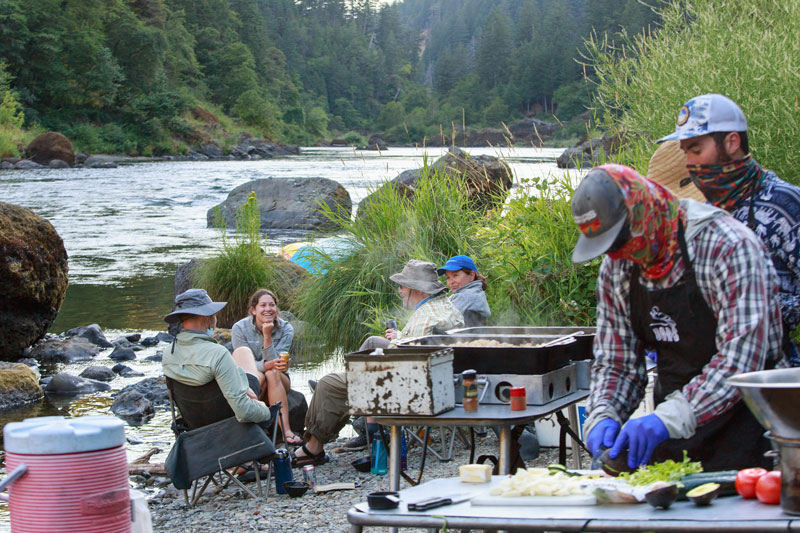
Last year, due to the COVID-19 pandemic, OARS had to cancel the first half of our season and we were unsure if we’d be able to run trips at all. Now, with a better understanding of the virus, effective protocols in place, and wider availability of vaccines and testing, outfitters are feeling more confident going into the 2021 rafting season. However, this is no time to let our guard down, and rafters should still expect many of the same COVID-19 protocols that were put in place during the 2020 season to minimize the risk of transmission on the river.
“We know and trust our COVID 19 Mitigation Plan,” says Nicole Lavoie, OARS Dinosaur Area Manager. “We’re ready to show off our ‘office’ and get people outside, enjoying this beautiful country and all of its hidden canyons.”
Below, our regional managers share more insights and projections about the 2021 rafting season.
What to Expect from the 2021 Rafting Season
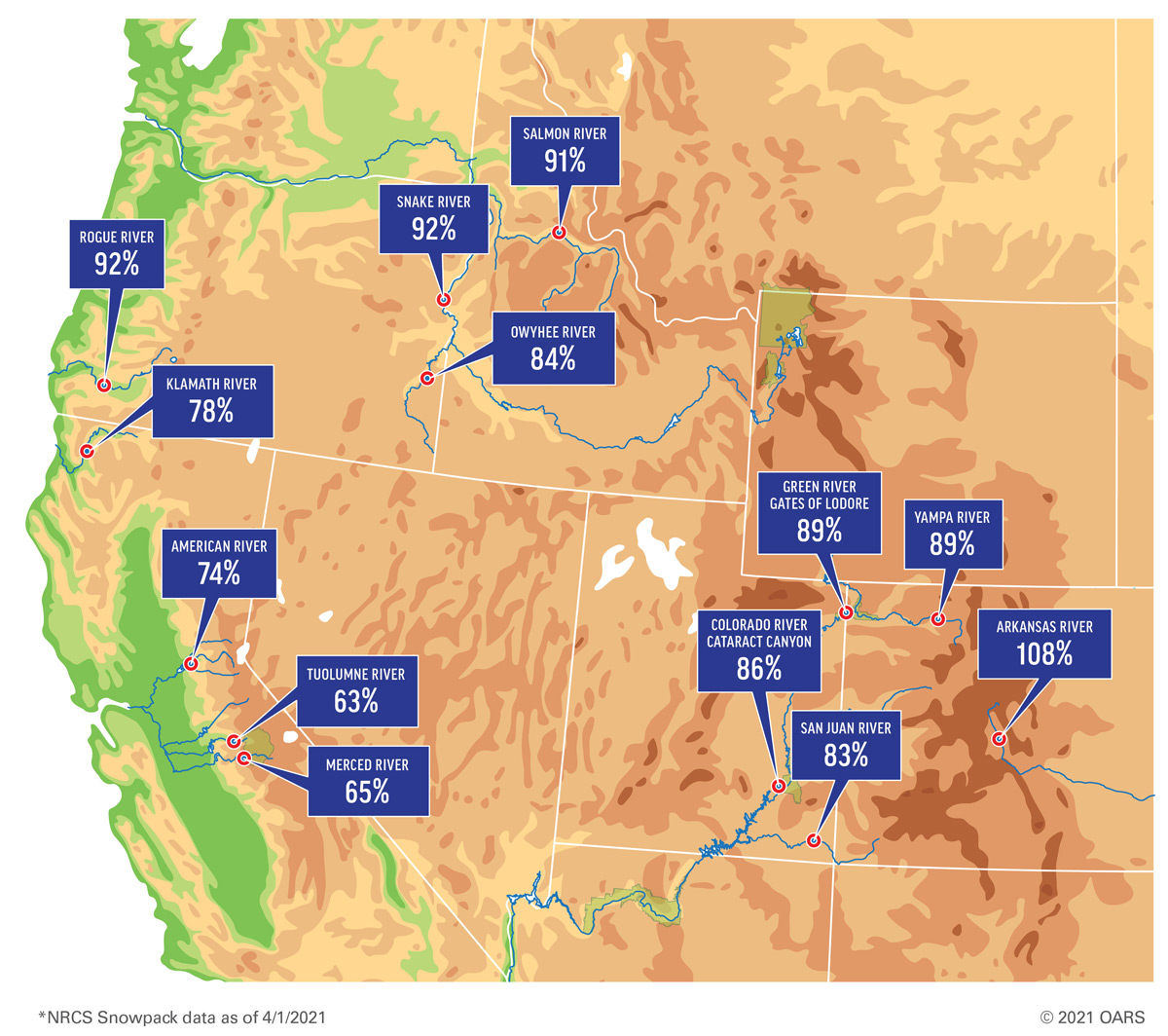
Where to Find the Best Whitewater: 2021 Key Takeaways
- There are few pockets in the Pacific Northwest and parts of Colorado where the snowpack is above average, but overall the snowpack across many of the major Western river basins is average to below average.
- This means it will be a relatively normal, lower water year without too many surprises and rafters can look forward to fun, low-stress flows throughout the summer on many of the West’s beloved whitewater rivers like Idaho’s Snake River, Utah’s Green River through the Gates of Lodore, as well as the Colorado River through Cataract Canyon.
- With rafting vacations in high demand this season, especially on Oregon’s Rogue River and Idaho’s Salmon River, travelers should plan early or look to super-scenic and oft-overlooked multi-day river trips in Utah like the Green River through Desolation Canyon and Colorado River through Westwater Canyon as impressive alternatives.
- In California, a mild winter and statewide snowpack that’s at 59% the normal average isn’t expected to heavily impact rafting on dam-controlled rivers like the American River near Sacramento and the Tuolumne River near Yosemite. Popular whitewater stretches without upstream reservoirs, like the Merced River near Yosemite and the North Fork of the American near Auburn, are on track to have abbreviated seasons due to the modest snowpack.
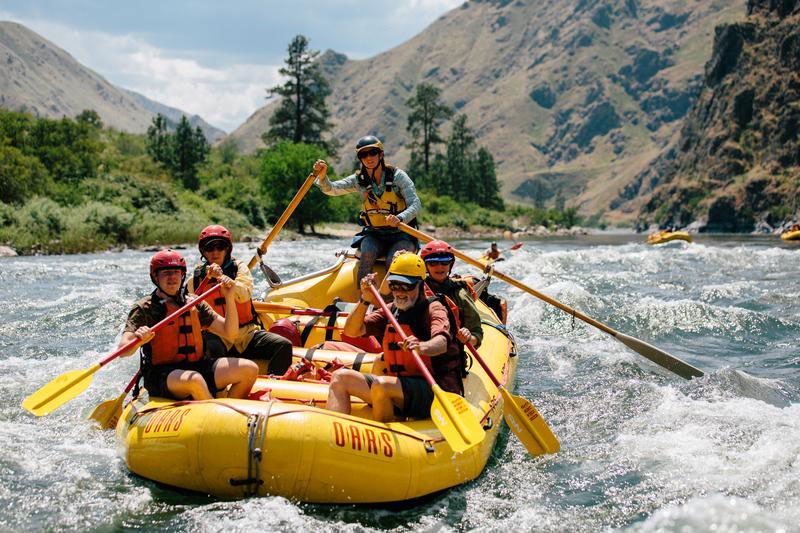
IDAHO
According to OARS Idaho Manager, Curt Chang, the “Idaho snowpack is at 93% of normal which means we will have a healthy summer in store, especially in the early months of June and July.”
For major river basins like the Salmon and Snake, which were hovering right above 90% as of the annual April 1 snow survey, Curt points out that, “We are lucky here in Idaho that our rivers are large enough that we could even get by with less [water] if we had to.”
Also good news for Idaho right now, says Curt, “Is that weather this spring is looking cool and wet which indicates that we may keep our snowpack longer and save the melt for the summer months.” This means peak flows will likely be the very end of May through the first week of June, with normal to lower flows predicted into September.
”We are feeling comfortable that Idaho rivers will be ideal for technical and big wave runs through the beginning of August with maybe a bit more work rowing by the end of summer, which is typical, but still splashy and fun,” says Curt.
OREGON
In Oregon, where the snowpack is above average for northern river basins like the John Day and Deschutes. In the southeastern region of the state, the Owyhee snowpack is sitting below average at 84%. Despite being below average, outfitters are hoping cooler spring temps and a slower melt might provide rafters with a sliver of opportunity for Owyhee rafting trips at the end of April if the current weather pattern continues.
For the Rogue River, where the snowpack is 92% of average, it will be “business as usual,” according to Oregon Regional Manager, Kate Wollney, and rafters can count on reliable flows from this dam-controlled river May through September. Additionally, she points out that it’s going to be a busy season on this classic whitewater run.
“We expect to be very close to sold out on the Rogue,” she says. “However, we feel we are very prepared to mitigate the continued COVID risks based on the success of our practices from last season.”
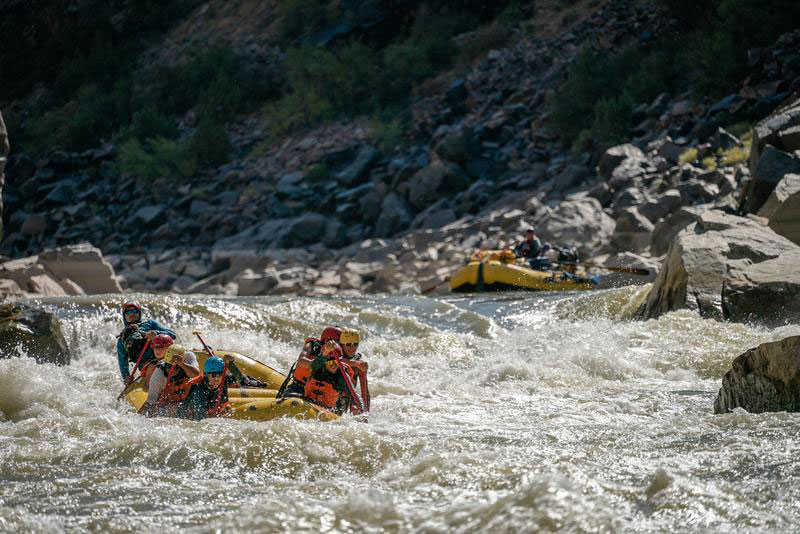
UTAH
In Utah, the snowpack is below average across the board with the exception of a small pocket near the northeastern border of the state in the Raft River Basin.
“We’re looking better than 2012, the last really low year in the last decade, but it’s still a low water year,” says Seth Davis, OARS Moab Regional Manager.
In the Upper Green River Basin, the snowpack measured 89% of average as of April 1 NRCS Snotel data. While this seems relatively normal, Nicole Lavoie, OARS Dinosaur Area Manager points out that the numbers may be a bit deceiving this year since 2020 was the driest year on record for Utah and the soil is incredibly dry, which might impact the snow to water equivalency in some areas.
Despite this, she adds that upstream reservoirs feed popular whitewater runs like the Green River through Flaming Gorge, Gates of Lodore, and even Desolation Canyon further downstream, which means paddlers can generally count on full commercial seasons into September, albeit with lower flows in below average snowpack years.
For example, “Because Gates of Lodore is dam released, even with the lowest flows we are still able to raft, so we will have a full season,” says Nicole.
For the Upper Colorado River Basin above Lake Powell, conditions are similar. The snowpack is currently 86% of normal, which means lower flows on Colorado River rafting trips in southeastern Utah like Weswater Canyon and Cataract Canyon, especially later in the season.
As of early April, the Colorado Basin River Forecast Center is predicting Cataract Canyon will peak around 25,000 CFS, most likely in late May, but if spring precipitation keeps coming, the peak may be higher, according to Seth. While the peak is expected to be below what many outfitters consider challenging high-water conditions that are often seen in Cataract Canyon in the spring, lower water levels can be a perk for rafters.
Seth points out that, “Lower flows mean paddle boats will be out more, better camps will generally be available, and things should be less buggy than in a wet year.”
Even further south, the San Juan River Basin snowpack is at 83% of normal. While this might create some challenging flows on the lower section of the San Juan later in the season, according to Seth, the upper stretch from Sand Island to Mexican Hat will have reliable flows for rafters throughout the summer.
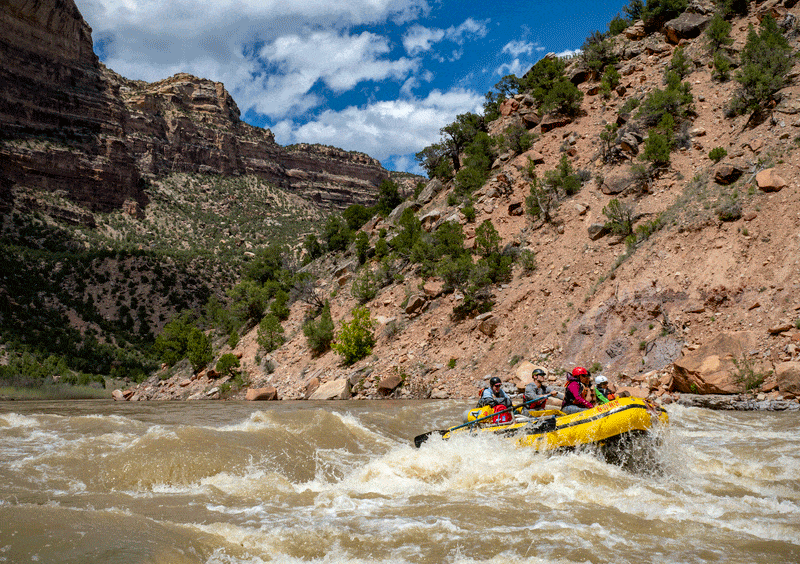
COLORADO
In Colorado, late winter storms helped boost the statewide snowpack, especially in the eastern side of the state where snowpack numbers landed in the average to slightly above average range. The Arkansas River Basin, which is currently at 108% of average, is one bright spot here and rafters can count on a long, healthy commercial rafting season on the Arkansas River through August.
For the free-flowing Yampa River in northwestern Colorado, where the snowpack is slightly below average at 89%, rafters will want to hop on an early season trip to guarantee the best flows.
CALIFORNIA
In California, it’s the second dry year in a row. The annual April 1 snow survey conducted by the California Department of Natural Resources shows a statewide snowpack that’s 59% of the historic average for this time of year. In the Sierra Nevada, which supplies 30% of the state’s water and feeds a number of the state’s most popular rafting rivers, the snowpack numbers for some of the key river basins are slightly better, ranging between 63% and 74%.
“With mild winters like the one we have had, the general public doesn’t think there is ‘enough’ water to go rafting, but that’s not true,” explains Chris Moore, OARS Angels Camp Area Manager.
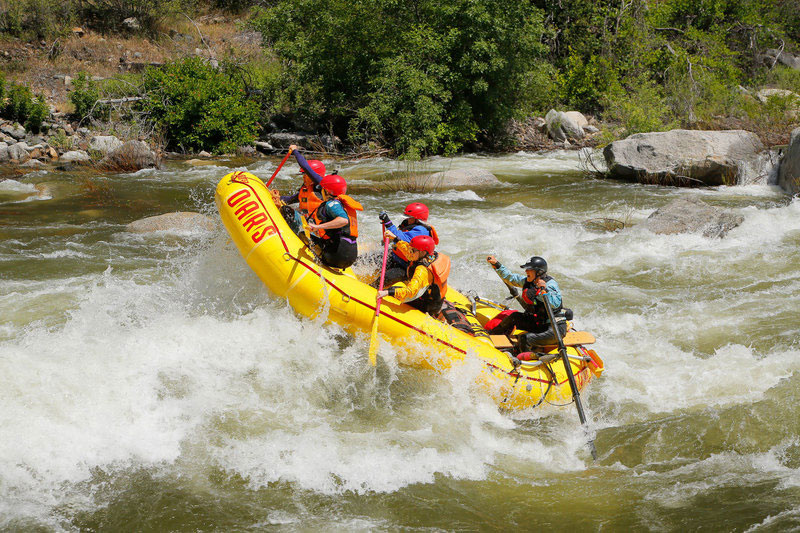
Despite looming drought concerns, the California rafting season is already underway. That’s because some of the most popular and accessible whitewater runs in the state, like the American River near Sacramento and the Tuolumne River near Yosemite, are dam-controlled and typically provide reliable recreational flows spring through late summer/early fall. As the state falls into “critically-dry” levels, however, some local water agencies have said they will release water fewer days for recreational access which will impact the weekly availability of some of California’s most popular whitewater rafting trips.
Right now based on what we know, “We are expecting normal dam release flows (1,100 CFS) on the Tuolumne for the season from Memorial Day to Labor Day,” says Chris. “There might be a couple of days that the water levels will push up to the 3,000 CFS range, but at this point we are not expecting very high water for any length of time.”
He acknowledges that there are some uncertainties going into this season on the Tuolumne since we typically can rely on snowmelt run-off to supply boatable flows through April and May. This year that run-off may be elusive, meaning the recreational flows supplied by the San Francisco Public Utilities Commission from Memorial Day through Labor Day will represent the heart of the rafting season.
As it stands now, we plan to get started in May, but for trips prior to Memorial Day when normal recreational releases from Hetch Hetchy Reservoir are expected, rafters may experience “lower than normal” flows in the 650-950 CFS range, according to Chris. “It’s still a fun trip at those levels, just a bit more technical than usual and the chances of getting ‘bumped’ out of the boat are mildly increased.”
On the free-flowing Merced River, a classic spring rafting trip on the other side of Yosemite, Chris adds that outfitters are expecting to see good flows from as early as mid-April to late-May or early-June.
Further north, Jess Wallstrom, OARS American River Regional Manager, says there will also be a short window of opportunity to catch the free-flowing North Fork American River this spring, most likely for several weeks in April. “If you want to catch the amazing wildflower displays California has to offer, this is a fantastic trip to do that,” she adds.
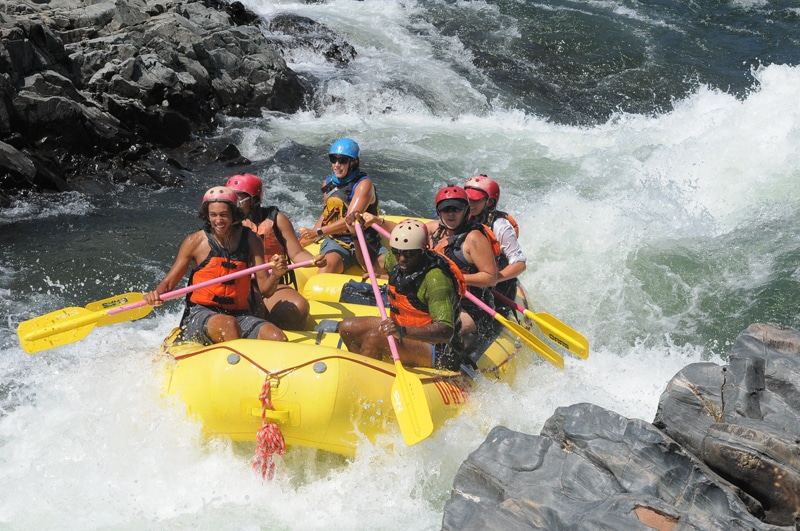
Even in a critically-dry year like 2021, rafters will be able to rely on average recreational flows on the South Fork and Middle Fork of the American River, though availability is dependent on area water agencies’ planned water releases.
On the popular South Fork, trips are currently available through mid-May, five days per week on a Friday through Tuesday schedule. From mid-May through Labor Day Weekend, trips will still be available five days per week, but availability will change to Thursday through Monday. Following Labor Day, from September 10 – 26, South Fork American rafting trips will be offered on the weekends only (Friday through Sunday), according to Jess.
On the Middle Fork, the peak season is expected to run Memorial Day through Labor Day Weekends this year with trips available four days per week, Friday through Sunday, plus Wednesdays. Following Labor Day Weekend, trips will be available on Saturdays only through September.
ARIZONA/GRAND CANYON
Though the Upper Basin above Reservoir Powell is still a bit below average in terms of snowpack, the Colorado River through Grand Canyon in Arizona is projected to flow at near-normal flows, according to Lars Haarr, OARS Grand Canyon Manager.
“That’s one advantage to a dam-controlled river section – it’s never too high or too low to run,” he says.
With months of departures cancelled last season, Grand Canyon rafting trips are in even higher demand than usual with some outfitters nearly sold out through 2022. To secure a spot, rafters will need to keep an eye out for last-minute cancellations, or plan for 2023.
Resources:
California Department of Water Resources – Snow Course Measurements
NRCS Idaho Snowpack Update SNOTEL Report
NRCS Oregon SNOTEL Snow/Precipitation Update Report
NRCS Colorado SNOTEL Snow Water Equivalent Update Graph
NRCS Upper Colorado River Snow/Precipitation Update Report
NRCS Colorado SNOTEL Snowpack Update Report
Photos: COVID protocols on a 2020 Rogue River trip – Cindi Stephen; Hells Canyon rafting – Andrew Miller; Colorado River rafting through Westwater Canyon – Rob Aseltine; Yampa River Rafting – Colleen Miniuk; Merced River rafting near Yosemite National Park – Rapid Shooter; South Fork American River Rafting in California – Hotshot Imaging
Related Posts
Sign up for Our Newsletter

